
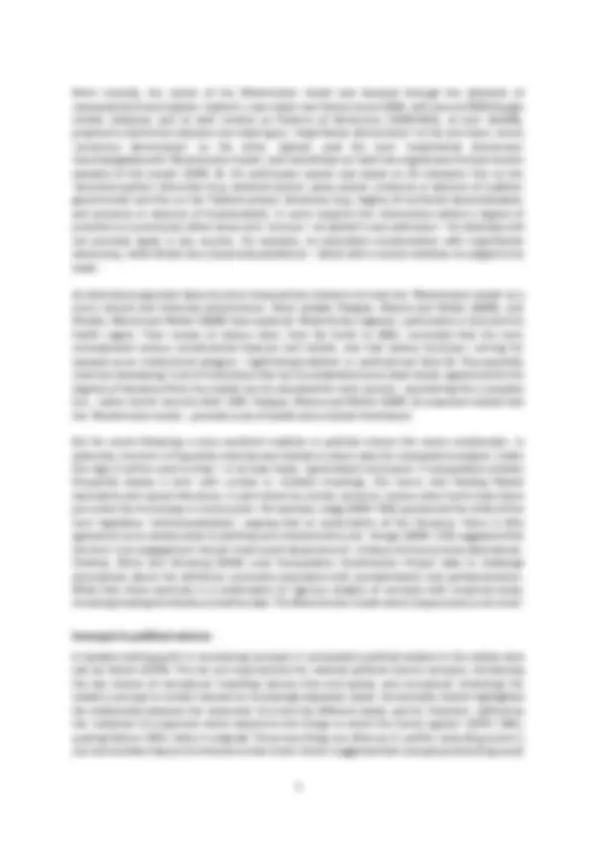

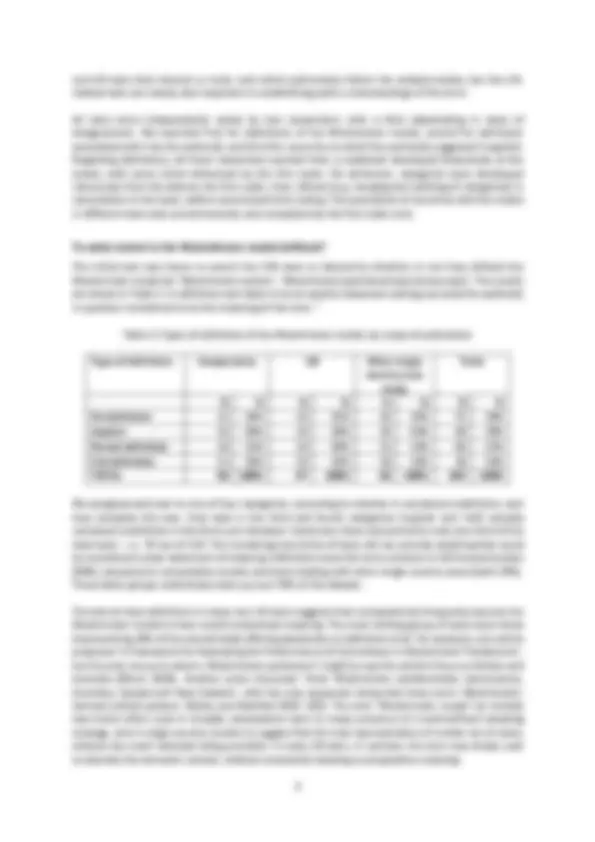
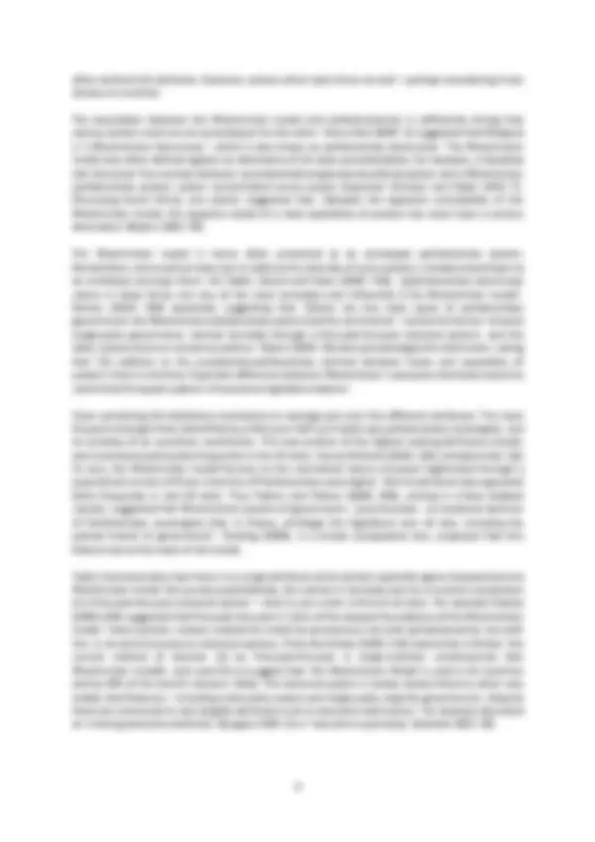
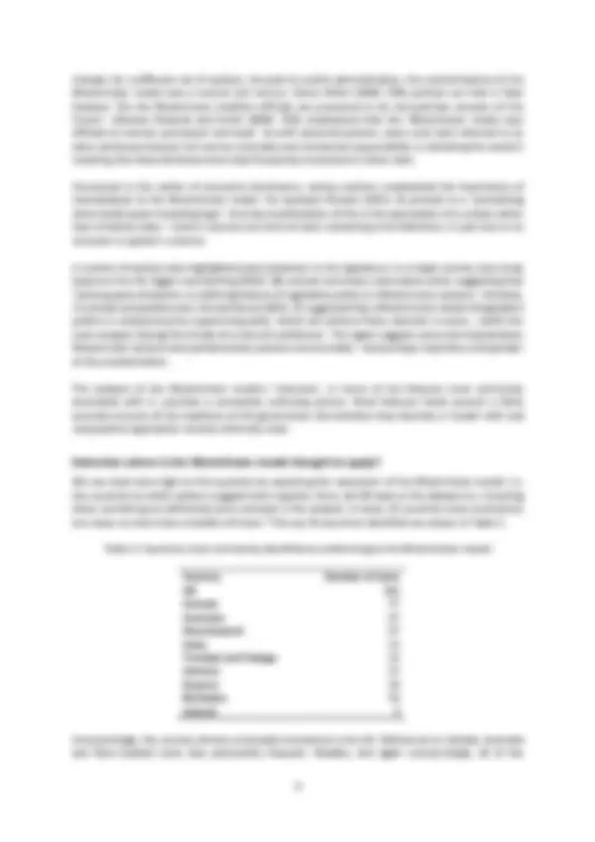
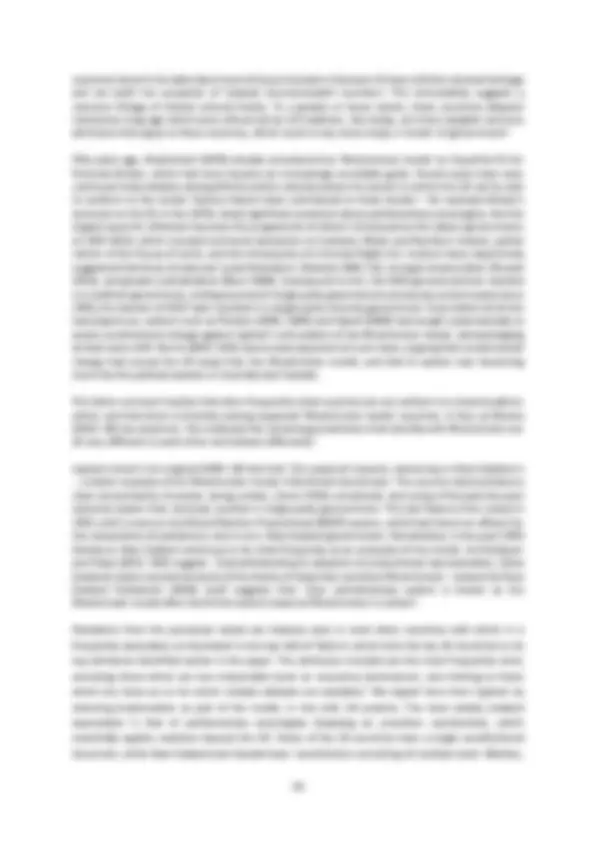
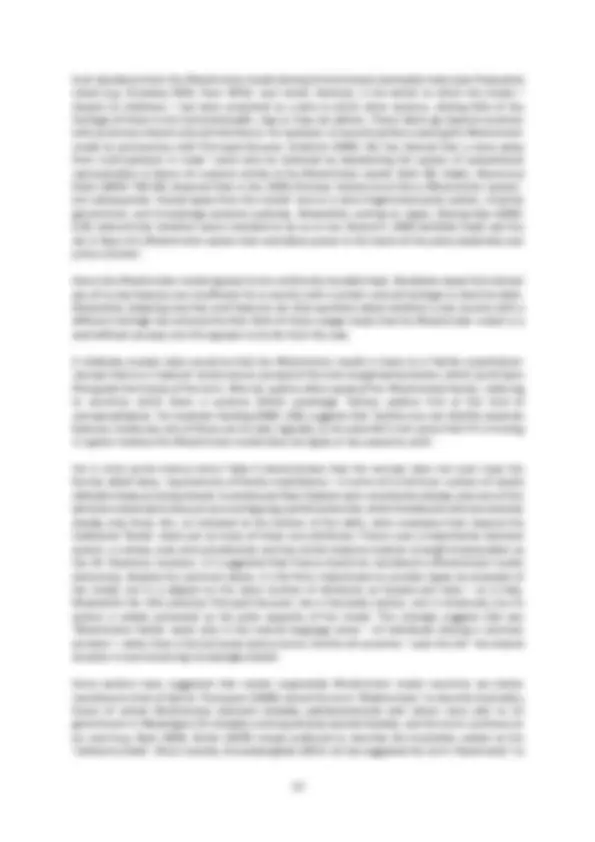
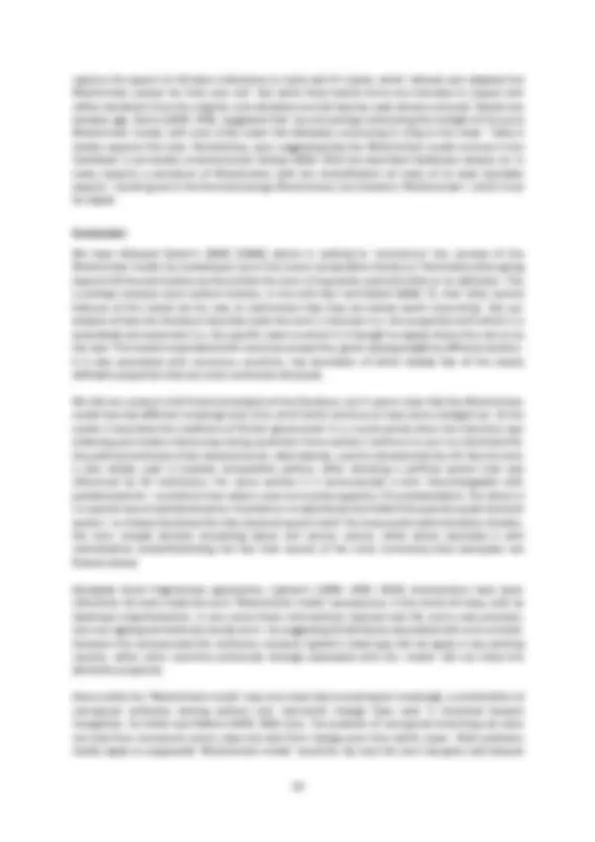





Study with the several resources on Docsity

Earn points by helping other students or get them with a premium plan


Prepare for your exams
Study with the several resources on Docsity

Earn points to download
Earn points by helping other students or get them with a premium plan
Community
Ask the community for help and clear up your study doubts
Discover the best universities in your country according to Docsity users
Free resources
Download our free guides on studying techniques, anxiety management strategies, and thesis advice from Docsity tutors
An analysis of the concept of the Westminster model in comparative politics. The authors examine how the term is used without clear definition and the conflicting attributes associated with it. They conclude that the Westminster model fails to meet the requirements of a classical political science concept. The document also discusses the countries often referred to as 'Westminster model countries' and the varying attributes observed in these countries.
What you will learn
Typology: Schemes and Mind Maps
1 / 19

This page cannot be seen from the preview
Don't miss anything!












Government and Opposition , Published online July 2020
The term ‘Westminster model’, widely used in both the academic and practitioner literature, is a familiar one. But detailed examination finds significant confusion about its meaning. This paper follows Giovanni Sartori’s advice for ‘reconstructing’ a social science term whose meaning may be unclear through review of its use in the recent literature. It finds that many authors in comparative politics use the term ‘Westminster model’ without definition, while those providing definitions associate it with a large (and sometimes conflicting) set of attributes, and a set of countries often not demonstrating those attributes. Some have sought to respect this diversity by proposing variants like “Washminster” or “Eastminster”, while others suggest that the term should be seen as a loose ‘family resemblance’ concept. But on examination it no longer meets even the – relatively weak – requirements for family resemblance. To end the muddle, and the risk of flawed inferences and false generalisation, comparative scholars should drop this term, and select cases based on more precise attributes instead.
The term ‘Westminster model’ appears frequently both in the academic and practitioner literature, and will be familiar to many specialists in comparative politics, public administration and law. But what precisely does it mean, and is there consistency in its application? If put under the microscope, can any clear meaning actually be discerned? This paper suggests that while ostensibly serving as a ‘model’ in the comparative literature, the term instead risks inducing muddle and unclear thinking. Following Giovanni Sartori’s advice for ‘reconstructing’ a social science term whose meaning may be unclear, our paper analyses uses of the term ‘Westminster model’ and its equivalents in the academic literature since 1999. We find that, while the term occurs frequently in comparative texts, authors’ interpretations of it are often unclear. Definitions are often absent, and where present, they are frequently partial, divergent, and sometimes even mutually contradictory. If a dominant interpretation exists, this is probably of a majoritarian parliamentary system – but such use is far from universal. Far better, if focusing on such systems, to state this explicitly. Too frequently scholars’ use of the term implies that empirical findings in single country or small-n studies have broader scope – which risks feeding flawed inferences and encouraging false generalisation. In order to avoid this, and to bring greater clarity to debates, we propose that the ‘Westminster model’ should now be retired from comparative politics – and more precise terms, based on the specific variables of interest, be put in its place. The paper proceeds as follows. First, we summarise the roots and general uses of the term ‘Westminster model’, which began as a descriptor in British politics, but developed over time to take on a more widely comparative use. We then review the literature on concept formation in political science, to consider the reasonable expectations for a useful political science term. Next, we briefly outline our methods. The substantive part of the paper is then structured around three key questions. First, to what extent do authors define the Westminster model at all? Second, where it is defined,
what are its suggested meanings and how much consistency exists? Third, having determined (as far as is possible) what the Westminster model is thought to mean, where is it considered to apply? We find that the countries commonly cited in the literature have relatively few key attributes in common, while sharing some important attributes with countries not normally associated with the model. Finally, we conclude, suggesting that the Westminster model fails the test for a classical political science concept, as well as the relatively weak requirements for a ‘family resemblance’ concept. It hence risks creating more confusion than illumination.
The term ‘Westminster model’ is linked by various authors to Walter Bagehot’s (2001[1867]) exposition of the ‘English’ constitution (e.g. Rhodes, Wanna and Weller 2009). It didn't actually appear in his text, but served – at least initially – as a convenient label for the system that he described. Subsequently it came increasingly to be used in a comparative context to describe countries influenced by the British system. It is now often deployed by comparativists to imply that there is a set of ‘Westminster model countries’ (e.g. Pinto-Duchinsky 1999), ‘Westminster democracies’ (e.g. Brenton 2014; Grube 2011; Kaiser 2008), countries adhering to a ‘Westminster system’ (e.g. Eggers and Spirling 201 6 ; Estevez-Abe 2006) or indeed members of a ‘Westminster family’ (e.g. Eichbaum and Shaw 2007: 613; Mulgan 2008: 457; Paun 2011: 452). Yet a superficial reading of recent comparative literature suggests at least some confusion about what the term actually means. The Oxford English Dictionary offers little clue: the term ‘Westminster model’ appears only once, within the more generic entry for ‘Westminster’, citing a classic text by De Smith (1961) on ‘Westminster’s export models’. This is not necessarily its earliest use, but a search of Google books since publication of Bagehot’s text shows that references grew sharply in the early 1960s (Figure 1). De Smith (1961: 3) himself took care to point out that ‘[t]he Westminster model will never be a legal term of art, and the political scientist may wish to handle it circumspectly’. But this clearly did little to discourage its subsequent popularity. Another classic text, J. P. Mackintosh’s ‘The Government and Politics of Britain’, whose first edition was published in 1970, used the ‘Westminster model’ as a framing device. For Mackintosh (1970: 28) it described ‘the idealised version of British government in the 1880-1914 period’; but he suggested that even then it had been an imperfect descriptor, while subsequent changes meant it had developed significant ability to ‘mislead’. Mackintosh however noted that the ‘model’ had been exported. His own writing may have inadvertently contributed to its increased comparative use. Figure 1: Occurrence of the term ‘Westminster model’ in English language texts published 1867 – 2008 and captured on Google books Source: Google Books Ngram Viewer (http://books.google.com/ngrams), generated 11 February 2019.^1
be avoided by ascending his well-known ‘ladder of abstraction’, to instead deploy a more general concept. Such considerations remain core to judging the essential attributes needed for political science concepts to be ‘good’ (Gerring 1999). In later work, Sartori made proposals for rigorous testing of concepts, and particularly for ‘reconstruction’ of categories whose meaning had become unclear. He suggested that ‘[c]oncept reconstruction is a highly needed therapy for the current state of chaos of most social sciences’, and proposed a three stage process to achieve this. ‘[F]irst collect a representative set of definitions; second, extract their characteristics; and third, construct matrices that organize such characteristics meaningfully’ (2009 [1984]: 122, 116). Hence the key is ‘reconstructing a concept from its literature ’ (ibid: 121, italics in original). We take our cue from this suggestion. It is important, however, to note that not all concepts are equal, and some require more parsimonious definition than others. Sartori was interested in ‘classical categorization, in which the relation among categories is understood in terms of a taxonomic hierarchy of successively more general categories’ (Collier and Mahon 1993: 145). A widely-noted alternative to this is the ‘family resemblance’ idea. Here, cases share a set of properties, but not all cases share them all. As Goertz (2006: 36) articulated, whereas a classical category requires members to share n attributes, ‘the family resemblance rule almost always takes the form of “ m of n ”’. Given the notion of a ‘Westminster family’, this logic might seem suited to the Westminster model. Indeed some authors (e.g. Patapan, Wanna and Weller 2005) have proposed this. We return to such suggestions towards the end of the paper.
Given the centrality of the term ‘Westminster model’ in Lijphart’s 1999 book, and the need to delimit our dataset, we began our search for meaning through an analysis of the academic literature starting at that point. Our endpoint is January 2017. Our search was primarily based on academic bibliographic databases, using English language texts.^2 We began with Scopus, using the set of largely interchangeable terms frequently found in the literature: ‘Westminster model’, ‘Westminster system’, ‘Westminster democracy’ and ‘Westminster parliamentary democracy’. We searched for these in the item’s abstract or keywords, or for the single word ‘Westminster’ within its title. This found over 150 items, of which around one-third were excluded as irrelevant – because they were not substantive articles, or discussed topics largely unrelated to political science, or used the term Westminster purely literally (e.g. articles on the Westminster parliament which mentioned no such ‘model’, ‘system’, etc). This search was repeated for the JSTOR database and on Google scholar, with duplicates removed. Altogether these searches resulted in 215 items, of which the great majority (20 2 ) were journal articles. Such database searches will tend to overlook definitions embedded in books, while core texts could be important to the dissemination of a popular term. We hence also conducted searches of university reading lists. Selecting the top 10 political science departments in US universities and top five equivalents in the UK (based on QS World University Rankings), we identified core recommended texts from broad-based undergraduate and postgraduate taught courses in comparative politics. Where reading lists were not available online, we requested these from course tutors. In addition, building inductively on our analysis of extension (see below) we did the same for broad-based domestic politics courses from the same UK universities, and the top three in each of Canada, Australia and New Zealand. This resulted in 27 textbooks, which were carefully searched (on paper if not available electronically). Excluding items that did not mention the term, this brought our total number of texts to 2 39. Of these, 90 were texts broadly in comparative politics, 67 focused on British politics, and the remaining 82 were single-country studies focused elsewhere than the UK. It is the comparative and
non-UK texts that interest us most, and which particularly inform the analysis below; but the UK- related texts are clearly also important in establishing public understandings of the term. All texts were independently coded by two researchers, with a third adjudicating in cases of disagreement. We searched first for definitions of the Westminster model, second for attributes associated with it by the author(s), and third for countries to which the author(s) suggested it applied. Regarding definitions, all three researchers worked from a codebook developed deductively at the outset, with some initial refinement by the first coder. For attributes, categories were developed inductively from the data by the first coder, then refined (e.g. merging and splitting of categories) in consultation in the team, before second and third coding. The association of countries with the model in different texts was uncontroversial, and completed by the first coder only.
The initial task was hence to search the 239 texts to determine whether or not they defined the Westminster model (or ‘Westminster system’, ‘Westminster [parliamentary] democracy’). The results are shown in Table 1. A definition was taken to be an explicit statement setting out what the author(s) in question considered to be the meaning of the term.^3 Table 1: Types of definition of the Westminster model, by scope of publication Type of definition Comparative UK Other single country case study Total N % N % N % N % No definition 31 34% 14 21% 26 32% 71 30% Implicit 36 40% 19 28% 35 43% 90 38% Partial definition 10 11% 19 28% 11 13% 40 17% Full definition 13 14% 15 22% 10 12% 38 16% TOTAL 90 100% 67 100% 82 100% 239 100% We assigned each text to one of four categories, according to whether it contained a definition, and how complete this was. Only texts in the third and fourth categories (‘partial’ and ‘full’) actually contained a definition in the form just indicated. Combined, these accounted for only one third of the total texts - i.e. 78 out of 239. The remaining two-thirds of texts did not provide anything that could be considered a clear statement of meaning. Definitions were far more common in UK-focused studies (50%) compared to comparative studies and texts dealing with other single country cases (both 25%). These latter groups collectively make up over 70% of the dataset. The lack of clear definitions in many non-UK texts suggests that comparativists frequently assume the Westminster model to have a well-understood meaning. The most striking group of texts were those (representing 30% of the overall total) offering absolutely no definition at all. For example, one article proposed ‘A Framework for Evaluating the Performance of Committees in Westminster Parliaments’, but the only clue as to what a ‘Westminster parliament’ might be was the article's focus on Britain and Australia (Monk 2010). Another piece discussed ‘three Westminster parliamentary democracies, Australia, Canada and New Zealand’, with the only expansion being that these were ‘Westminster- derived judicial systems’ (Kerby and Banfield 2014: 342). The term ‘Westminster model’ (or similar) was hence often used in broadly comparative texts to imply presence of a well-defined sampling strategy, and in single country studies to suggest that this was representative of a wider set of cases, without any overt rationale being provided. In many UK texts, in contrast, the term was simply used to describe the domestic context, without necessarily implying a comparative meaning.
The attributes listed are diverse, and the boundaries between them sometimes blurred. As in Lijphart’s version of the model, some attributes (such as a two-party system and single-party majority government) are clearly interlinked. Others (e.g. executive dominance, or adversarial political culture) would be difficult to define or measure precisely, and are closer to being consequences of the model than institutional rules. Notably, the table also demonstrates some direct contradiction: eight texts (primarily in an application of Lijphart) considered unicameralism or quasi-unicameralism to be part of the model, while six authors instead associated it with bicameralism. For example Anckar (2007:
often omitted this attribute. However, various other texts did so as well – perhaps considering it too obvious to mention. The association between the Westminster model and parliamentarism is sufficiently strong that various authors took one as a pseudonym for the other. Hence Bari (2007: 2) suggested that Malaysia is ‘a Westminster democracy – which is also known as parliamentary democracy’. The Westminster model was often defined against an alternative of US-style presidentialism; for example, a Canadian text discussed ‘the contrast between a presidential/congressional political system and a Westminster parliamentary system: power concentrated versus power dispersed’ (Simeon and Radin 2010: 7). Discussing South Africa, one author suggested that ‘[d]espite the apparent unsuitability of the Westminster model, the opposite model of a clear separation of powers has never been a serious alternative’ (Nijzinc 2001: 54). The Westminster model is hence often presented as an archetypal parliamentary system. Nonetheless, some authors take care to address the diversity of such systems, instead presenting it as an archetype amongst them. For Strøm, Narud and Valen (2005: 782), ‘[p]arliamentary democracy comes in many forms, but one of the most venerable and influential is the Westminster model’. Norton (2014: 269) expanded, suggesting that ‘[t]here are two basic types of parliamentary government: the Westminster parliamentary system and the continental’ – where the former ‘stresses single-party government, elected normally through a first-past-the-post electoral system’, and the latter ‘places stress on consensus politics‘. Nijzinc (2001: 55) also acknowledged this distinction, noting that ‘[i]n addition to the presidential-parliamentary contrast between fusion and separation of powers, there is a further important difference between Westminster’s executive dominance and the continental European pattern of executive-legislative balance‘. Texts containing full definitions mentioned on average just over five different attributes. The most frequent amongst them (identified by a little over half such texts) was parliamentary sovereignty, and its corollary of an unwritten constitution. This was another of the highest ranking attributes overall, and mentioned particularly frequently in the UK texts. Hence Mitchell (2010: 101) indicated that ‘[a]t its core, the Westminster model focuses on the centralised nature of power legitimated through a popularised version of Dicey’s doctrine of Parliamentary sovereignty’. But the attribute also appeared fairly frequently in non-UK texts. Thus Palmer and Palmer (2004: 596), writing in a New Zealand context, suggested that ‘Westminster systems of government… [are] founded… on a bedrock doctrine of Parliamentary sovereignty that, in theory, privileges the legislature over all else, including the judicial branch of government’. Harding (2004), in a broad comparative text, proposed that this feature was at the heart of the model. Table 2 demonstrates how there is no single attribute which authors explicitly agree characterises the Westminster model. But purely quantitatively, the contest is narrowly won by a country's possession of a first-past-the-post electoral system – cited in just under a third of all texts. For example Vowles (2000: 684) suggested that first-past-the-post is ‘[o]ne of the deepest foundations of the Westminster model’. Some authors, indeed, treated the model as synonymous not with parliamentarism, but with this. In an article focused on electoral systems, Pinto-Duchinsky (1999: 116) stated that in Britain ‘the current method of election [is] by first-past-the-post in single-member constituencies (the Westminster model)’, and used this to suggest that ‘the Westminster Model is used in 62 countries and by 49% of the world’s electors’ (ibid). This electoral system is clearly closely linked to other very widely cited features – including a two-party system and single-party majority governments. Likewise these are connected to less tangible attributes such as executive dominance – for example described as ‘a strong executive authority’ (Burgess 1999: 3) or ‘executive supremacy’ (Gamble 2003: 20).
countries listed in the table (and most of those included in footnote 3 ) have a British colonial heritage and are (with the exception of Ireland) Commonwealth members. This immediately suggests a common linkage of shared cultural history. To a greater or lesser extent, these countries adopted institutions long ago which were influenced by UK traditions. But today, are there tangible common attributes that apply to these countries, which could in any sense imply a ‘model’ of government? Fifty years ago, Mackintosh (1970) already considered the ‘Westminster model’ an imperfect fit for Victorian Britain, which had since become an increasingly unreliable guide. Recent years have seen continued lively debates among British politics scholars about the extent to which the UK can be said to conform to the model. Various factors have contributed to these doubts – for example Britain’s accession to the EU in the 1970s raised significant questions about parliamentary sovereignty. But the largest cause for reflection has been the programme of reform introduced by the Labour governments of 1997-2010, which included territorial devolution to Scotland, Wales and Northern Ireland, partial reform of the House of Lords, and the introduction of a Human Rights Act. Authors have respectively suggested that these introduced ‘quasi federalism’ (Gamble 2006: 22), stronger bicameralism (Russell 2013), and greater judicialisation (Bevir 2008). Subsequent to this, the 2010 general election resulted in a coalition government, ending a period of single-party governments previously uninterrupted since 1945 ; the election of 2017 later resulted in a single-party minority government. Even before all of this had played out, authors such as Flinders (2005, 2009) and Hazell (2008) had sought systematically to assess constitutional change against Lijphart’s articulation of the Westminster model, acknowledging at least some shift. Norris (2001: 881) was an early exponent of such views, arguing that constitutional change had moved the UK away from the Westminster model, and that its system was ‘becoming more like the political systems in Australia and Canada’. This latter comment implies that other frequently-cited countries do not conform to a shared pattern either, and that there is diversity among supposed ‘Westminster model' countries. In fact, as Wanna (2014: 20) has observed, ‘the relatively few remaining jurisdictions that identify with Westminster are all very different to each other and behave differently’. Lijphart noted in his original (1984: 19) text that ‘[i]n nearly all respects, democracy in New Zealand is … a better example of the Westminster model, than British democracy’. The country demonstrated a clear concentration of power, being unitary, (since 1 952 ) unicameral, and using a first-past-the-post electoral system that routinely resulted in single-party governments. This last feature then ended in 1993, with a move to the Mixed Member Proportional (MMP) system, which had knock-on effects for the composition of parliament, and in turn, New Zealand governments. Nonetheless, in the post- 1999 literature, New Zealand continues to be cited frequently as an exemplar of the model. As Eichbaum and Shaw (2011: 585) suggest, ‘[n]otwithstanding its adoption of proportional representation, [New Zealand] retains several elements of the family of ideas that constitute Westminster’. Indeed the New Zealand Parliament (2014) itself suggests that ‘[o]ur parliamentary system is known as the Westminster model after the British system based at Westminster in London’. Deviations from the perceived model are likewise seen in most other countries with which it is frequently associated, as illustrated in the top half of Table 4, which links the top 10 countries to six key attributes identified earlier in the paper. The attributes included are the most frequently cited, excluding those which are less measurable (such as ‘executive dominance’), and limiting to those which are clear-cut or for which reliable datasets are available.^5 We depart here from Lijphart by selecting bicameralism as part of the model, in line with UK practice. The most widely violated expectation is that of parliamentary sovereignty (implying an unwritten constitution), which essentially applies nowhere beyond the UK. Seven of the 10 countries have a single constitutional document, while New Zealand and Canada have ‘constitutions consisting of multiple texts’ (Melton,
Stuart and Helen 2015: 10). Beyond this, most other countries violate at least one further expectation. Indeed this particularly applies among the countries most widely cited as adhering to the model. The UK itself reliably demonstrates only four of the six key attributes, while most other cases reliably demonstrate no more than three.
Such deviations from the Westminster model among its best-known exemplars have been frequently noted (e.g. Dunleavy 2010, Paun 2011). Less noted, however, is the extent to which the model – despite its shakiness – has been presented as a pole to which other systems, sharing little of the heritage of those in the Commonwealth, may or may not adhere. These claims go beyond countries with an obvious shared cultural inheritance. For example, in line with authors viewing the Westminster model as synonymous with first-past-the-post, Kretzmer (2006: 61) has claimed that a move away from multi-partyism in Israel ‘could only be achieved by abandoning the system of proportional representation in favour of a system similar to the Westminster model’ (ibid: 65). Strøm, Narud and Valen (2005: 785-86) observed that in the 1960s Norway ‘looked much like a Westminster system’, but subsequently ‘moved away from this model’ due to a more fragmented party system, minority government, and increasingly assertive judiciary. Meanwhile, writing on Japan, Estevez-Abe (2006:
capture the export of UK-style institutions to India and Sri Lanka, which ‘altered and adapted the Westminster system for their own soil’. But while these hybrid terms are intended to respect and reflect deviations from the original, such deviations are (at least by now) almost universal. Nearly two decades ago, Norris (2001: 878), suggested that ‘we are perhaps witnessing the twilight of the pure Westminster model, with only a few states like Barbados continuing to cling to this ideal’. Table 4 clearly supports this view. Nonetheless, even suggesting that the Westminster model survives in the Caribbean is not wholly uncontroversial. Bishop (2001: 421) has described Caribbean variants as ‘in many respects a caricature of Westminster with the intensification of many of its least desirable aspects’, resulting not in the formerly-benign Westminster, but instead a ‘Westmonster’, which must be slayed.
We have followed Sartori’s (2009 [1984]) advice in seeking to ‘reconstruct’ the concept of the Westminster model, by reviewing its use in the recent comparative literature. Particularly when going beyond UK-focused studies we found that the term is frequently used with little or no definition. This is perhaps because some authors believe, in line with Kerr and Kettell (2006: 7), that ‘[t]he central features of this model are by now so well-known that they are barely worth recounting’. But our analysis of how the literature describes both the term’s intension (i.e. the properties with which it is associated) and extension (i.e. the specific cases to which it is thought to apply) shows this not to be the case. The model is associated with numerous properties, given varying weight by different authors. It is also associated with numerous countries, key exemplars of which display few of the clearly definable properties that are most commonly discussed. We did not conduct a full historical analysis of the literature, but it seems clear that the Westminster model has had different meanings over time, all of which continue to have some vestigial use. At the outset it described the traditions of British government in a crucial period when the franchise was widening and modern democracy being cemented. Some authors continue to use it as shorthand for the political institutions that characterise (or, alternatively, used to characterise) the UK. But the term is also widely used in broader comparative politics, often denoting a political system that was influenced by UK institutions. For some authors it is (erroneously) a term interchangeable with parliamentarism – as distinct from what is seen as its polar opposite, US presidentialism. For others it is a special case of parliamentarism, founded on a majoritarian (normally first-past-the-post) electoral system – or indeed shorthand for that electoral system itself. For many public administration scholars, the term instead denotes something about civil service culture, while others associate it with centralisation (notwithstanding the fact that several of the most commonly-cited exemplars are federal states). Alongside these fragmentary approaches, Lijphart’s (1984, 1999, 2012) interventions have been influential. His work made the term ‘Westminster model’ synonymous, in the minds of many, with an ideal-type majoritarianism. In one sense these interventions injected new life, and a new precision, into a an ageing and distinctly cloudy term – by suggesting 10 attributes associated with such a model. However this compounded the confusion, because Lijphart’s ideal type did not apply in any existing country, while some countries previously strongly associated with the ‘model’ did not share the attributes proposed. Hence while the ‘Westminster model’ may once have had a meaning (or meanings), a combination of conceptual confusion among authors and real-world change have seen it stretched beyond recognition. As Collier and Mahon (1993: 845) note, ‘the problem of conceptual stretching can arise not only from movement across cases but also from change over time within cases’. Both problems clearly apply to supposedly ‘Westminster model’ countries. By now the term has gone well beyond
Bevir M ( 2008 ) “The Westminster Model, Governance and Judicial Reform.” Parliamentary Affairs 61 (4), 559 - 77. Bishop ML ( 2011 ) “Slaying the ‘Westmonster’ in the Caribbean? Constitutional reform in St Vincent and the Grenadines.” British Journal of Politics and International Relations 13 (3), 420 - 437. Bittner A and Koop R ( 2013 ) Parties, Elections, and the Future of Canadian Politics , Vancouver: UBC Press. Brenton S ( 2014 ) “Ministerial accountability for departmental actions across Westminster parliamentary democracies.” Australian Journal of Public Administration , 73 (4), 467 - 481. Burgess M ( 1999 ) “Obstinate or obsolete? The state of the Canadian federation.” Regional and Federal Studies , 9 (2), 1 - 15. Butler D ( 1974 ) The Canberra Model: Essays on Australian Government. 2nd edn. London: Macmillan. Caramani D ( 2017 ) Comparative Politics , 4 th edn. Oxford: Oxford University Press. Cheibub J, Elkins Z and Ginsburg T ( 2014 ) “Beyond Presidentialism and Parliamentarism.” British Journal of Political Science 44 (3), 515 - 544. Collier D and Mahon J ( 1993 ) “Conceptual ‘Stretching’ Revisited: Adapting Categories in Comparative Analysis.” The American Political Science Review 87 (4), 845 - 855. De Smith SA ( 1961 ) “Westminster’s export models: the legal framework of responsible government.” Journal of Commonwealth Studies 1 (1), 3 – 16. Dunleavy P ( 2010 ) “Every key ‘Westminster model’ country now has a hung Parliament, following Australia’s ‘dead heat’ election.” LSE British Politics and Policy Blog , August 23. https://blogs.lse.ac.uk/politicsandpolicy/every-key-%e2%80%98westminster- model%e2%80%99-country-now-has-a-hung-parliament-following- australia%e2%80%99s-%e2%80%98dead-heat%e2%80%99-election/ (accessed 5 December 2019). Eggers A and Spirling A ( 2016 ) “Party Cohesion in Westminster Systems: Inducements, Replacement and Discipline in the House of Commons, 1836-1910.” British Journal of Political Science 46 (3), 567 - 89. Eichbaum C and Shaw R ( 2007 ) “Ministerial advisers, politicization and the retreat from Westminster: The case of New Zealand.” Public Administration 85 (3), 609 - 640. Eichbaum C and Shaw R ( 2011 ) “Political staff in executive government: Conceptualising and mapping roles within the core executive.” Australian Journal of Political Science 46 (4), 584 - 616. Estevez-Abe M ( 2006 ) “Japan’s shift toward a Westminster system: A structural analysis of the 2005 lower house election and its aftermath.” Asian Survey 46 (4), 632 - 651. Flinders M ( 2005 ) “Majoritarian Democracy in Britain.” West European Politics 28 (1), 62 - 94. Flinders M ( 2006 ) “‘The Half-Hearted Constitutional Revolution.’” In Dunleavy P, Heffernan R, Cowley P and Hay C (eds.), Developments in British Politics 8. Basingstoke: Palgrave Macmillan, pp. 117- 137 Flinders M ( 2009 ) Democratic Drift: Majoritarian Modification and Democratic Anomie in the United Kingdom. Oxford: Oxford University Press. Flinders M ( 2011 ) “Devolution, delegation and the Westminster model: A comparative analysis of developments within the UK, 1998-2009.” Commonwealth and Comparative Politics 49 (1), 1 -
Gamble A ( 2003 ) ‘Remaking the Constitution’. In Dunleavy P, Gamble A, Heffernan R and Peele G (eds.), Developments in British Politics 7. Basingstoke: Palgrave Macmillan, pp. 18-38. Gamble A ( 2006 ) “The Constitutional Revolution in the United Kingdom.” Publius: The Journal of Federalism 36 (1), 19 - 35. Gerring J ( 1999 ) “What Makes a Concept Good? A Criterial Framework for Understanding Concept Formation in the Social Sciences.” Polity 31 (3), 357 - 393. Goertz G ( 2006 ) Social Science Concepts: A User’s Guide. Princeton and Oxford: Princeton University Press.
Grube D ( 2011 ) “Speech cycle? 'Election-defining rhetoric' in Westminster democracies.” Australian Journal of Political Science 46 (1), 35 - 52. Harding A ( 2004 ) “The ‘Westminster Model’ Constitution Overseas: Transplantation, Adaptation and Development in Commonwealth States.” Oxford University Commonwealth Law Journal 4 (2), 143 - 166. Hazell R ( 2008 ) “‘Conclusion: Where Will the Westminster Model End Up?’” In Hazell R (ed.), Constitutional futures revisited: Britain’s constitution to 2020. Basingstoke: Palgrave Macmillan, pp. 285-300. Heath A, Glouharova S and Heath O ( 2006 ) “‘India: Two-Party Contests within a Multiparty System.’” In Gallagher M and Mitchell P (eds.), The Politics of Electoral Systems. Oxford: Oxford University Press, pp. 137-156. Hendriks F and Michels A ( 2011 ) “Democracy Transformed? Reforms in Britain and The Netherlands (1990–2010).” International Journal of Public Administration 34 (5), 307 - 317. Hix S and Noury A ( 2016 ) “‘Government-Opposition or Left-Right? The Institutional Determinants of Voting in Legislatures.’” Political Science Research and Methods 4 (2), 249 - 273. Hopkin J and Bradbury J ( 2006 ) “British Statewide Parties and Multilevel Politics.” Publius: The Journal of Federalism 36 (1), 135 - 152. Johnston R ( 2010 ) “Political Parties and the Electoral System.” In Courtney J C (ed.), The Oxford Handbook of Canadian Politics. Oxford: Oxford University Press, pp. 208-223. Judge D ( 2003 ) “Legislative Institutionalization: A Bent Analytical Arrow?” Government and Opposition 38 (4), 497 - 516. Kaiser A ( 2008 ) “Parliamentary Opposition in Westminster Democracies: Britain, Canada, Australia and New Zealand.” The Journal of Legislative Studies 14 (1), 20 - 45. Kavanagh D, Richards D, Geddes A and Smith M ( 2006 ) British Politics , Oxford: Oxford University Press. Kerby M and Banfield AC ( 2014 ) “The determinants of voluntary judicial resignation in Australia, Canada, and New Zealand.” Commonwealth and Comparative Politics 52 (3), 335 - 357. Kerr P and Kettell S ( 2006 ) “In defence of British politics: The past, present and future of the discipline.” British Politics 1 (1), 3 - 25. Kopecký, P, Meyer Sahling, J. H, Panizza, F, Scherlis, G, Schuster, C and Spirova, M (2016) “Party patronage in contemporary democracies: Results from an expert survey in 22 countries from five regions” European Journal of Political Research , 55 (2), 416-431. Kretzmer D ( 2006 ) “Experimenting with constitutional change: Direct election of the prime minister in Israel.” European Constitutional Law Review 2 ( 1 ), 60 - 80. Kumarasingham H ( 2013 ) A Political Legacy of the British Empire: Power and the Parliamentary system in Post-Colonial India and Sri Lanka. London and New York: I.B. Tauris. Leach R , Coxall B and Robins L ( 2011 ) British Politics. Basingstoke: Palgrave Macmillan. Lijphart A ( 1984 ) Democracies: Patterns of Majoritarian and Consensus Government in Twenty-One Countries. New Haven and London: Yale University Press. Lijphart A ( 1999 ) Patterns of Democracy: Government Forms and Performance in Thirty-Six Countries. London and New Haven: Yale University Press. Lijphart A ( 2012 ) Patterns of Democracy: Government Forms and Performance in Thirty-Six Countries. 2 nd edn. London and New Haven: Yale University Press. Mackintosh J P (1970) The Government and Politics of Britain. London: Hutchinson. Melton J, Stuart C and Helen D ( 2015 ) To Codify or Not to Codify? London: Constitution Unit. Miller R ( 2006 ) New Zealand Government and Politics. Oxford: Oxford University Press. Miller R ( 2015 ) Democracy in New Zealand. Auckland: Auckland University Press. Mitchell J ( 2010 ) “The narcissism of small differences: Scotland and Westminster.” Parliamentary Affairs 63 (1), 98 - 116. Monk D ( 2010 ) “A framework for evaluating the performance of committees in Westminster parliaments.” Journal of Legislative Studies 16 (1), 1 - 13.
(^1) The graph shows the occurrence of the term as a proportion of all two-word phrases in texts captured by Google books from each given year (see https://books.google.com/ngrams/info). Note this is a relative, not an actual measure: as the number of books published has also risen sharply, the growth in actual incidence of the term would be far steeper. (^2) As with respect to the Google books search above, there is of course a possibility that the term is used with greater nuance in non-English language texts. This remains untested, but there is no particular reason to believe that it would be the case. (^3) More fully: a definition needed to include an explicit statement of meaning, the term being mentioned followed by a statement describing its significance. The statement of significance might or might not be followed by a list of associated attributes. A ‘full’ definition defined the term extensively, the author listing attributes associated with the model and discussing their functioning. A ‘partial’ definition mentioned the term followed by a statement describing its significance, but this could be weak or underdeveloped.
(^5) For example, we were unable to find a reliable source for which countries possess a 'neutral civil service', despite consulting scholars of comparative public administration. Those datasets that exist (e.g. see Kopecký et al 2016) are based on expert surveys and composite scales for degrees of political involvement in public appointments, rather than providing an uncontroversial dichotomous categorisation. (^6) Sartori suggested that ‘ Individual ambiguity is a single author’s confusion’, while ‘ Collective ambiguity attests, instead, to an infelicitous state of a discipline as such… [where] each scholar ascribes his own meanings to his key terms’ (2009 [1984]: 111, italics in original).